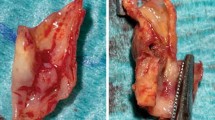Abstract
Background To evaluate the ability of ultrahigh-field magnetic resonance imaging (MRI) to accurately depict the composition of the human arterial vessel wall ex vivo and to detect early atherosclerotic lesion formation in comparison to histology.
Methods Eight iliac artery specimens with low-grade atherosclerotic lesions obtained from human organ donors were studied. Three-dimensional, high-resolution MRI (spatial resolution: 79 × 79 × 109 μm) was performed using T1-, T2- and proton density (PD)-weightings (7.0 Tesla MR system, Bruker Pharmascan). A total of 36 MR slices and corresponding histological sections were matched for comparative evaluation of area measurements of lumen, media and adventitia and—if present—plaque size. Statistical correlation between histology and MR measurements was tested and a ROC-analysis was performed to determine the plaque size being predictive of correctly identifying atherosclerotic lesions with MRI.
Results The areas of vessel lumen and media as measured on T1-, T2- and PD-weighted MR images showed a strong correlation with the corresponding histological measurements (r = 0.84 to r = 0.89; P < 0.01), however, a systematic overestimation of 34–41% was found. For the area of adventitia, only a moderate, though significant, correlation (r = 0.55 to r = 0.62; P < 0.01) could be demonstrated with a similar overestimation by MRI (38–43%). With T1-weighted MRI, sensitivity and specificity for the detection of plaques > 4.0 mm2 were 79% and 91%, respectively. With T2- and PD-weighted MRI, however, sensitivity and specificity for the detection of plaques > 0.4 mm2 were 93% and 89%.
Conclusions In an experimental ex vivo setting, ultrahigh-field MRI of the human arterial vessel wall resulted in an accurate visualization of vessel wall composition when compared to histology and, thus, allowed for a quantitative assessment. T2- and PD-weighted MRI proved capable of reliably detecting submillimeter atherosclerotic lesions.





Similar content being viewed by others
References
Casscells W, Naghavi M, Willerson JT (2003) Vulnerable atherosclerotic plaque: a multifocal disease. Circulation 107(16):2072–2075
Fuster V, Corti R, Fayad ZA et al (2003) Integration of vascular biology and magnetic resonance imaging in the understanding of atherothrombosis and acute coronary syndromes. J Thromb Haemost 1(7):1410–1421
Fayad ZA, Fuster V, Nikolaou K et al (2002) Computed tomography and magnetic resonance imaging for noninvasive coronary angiography and plaque imaging: current and potential future concepts. Circulation 106(15):2026–2034
Nikolaou K, Becker CR, Flohr T et al (2004) Optimization of ex vivo CT- and MR- imaging of atherosclerotic vessel wall changes. Int J Cardiovasc Imaging 20(4):327–334
Yang F, Holzapfel G, Schulze-Bauer C et al (2003) Segmentation of wall and plaque in in vitro vascular MR images. Int J Cardiovasc Imaging 19(5):419–428
Helft G, Worthley SG, Fuster V et al (2001) Atherosclerotic aortic component quantification by noninvasive magnetic resonance imaging: an in vivo study in rabbits. J Am Coll Cardiol 37(4):1149–1154
Fayad ZA, Nahar T, Fallon JT et al (2000) In vivo magnetic resonance evaluation of atherosclerotic plaques in the human thoracic aorta: a comparison with transesophageal echocardiography. Circulation 101(21):2503–2509
Saam T, Ferguson MS, Yarnykh VL et al (2005) Quantitative evaluation of carotid plaque composition by in vivo MRI. Arterioscler Thromb Vasc Biol 25(1):234–239
Cai J, Hatsukami TS, Ferguson MS et al (2005) In vivo quantitative measurement of intact fibrous cap and lipid-rich necrotic core size in atherosclerotic carotid plaque: comparison of high-resolution, contrast-enhanced magnetic resonance imaging and histology. Circulation 112(22):3437–3444
Bruemmer D, Riggers U, Holzmeister J et al (2001) Expression of CD40 in vascular smooth muscle cells and macrophages is associated with early development of human atherosclerotic lesions. Am J Cardiol 87(1):21–27
Hanley JA, McNeil BJ (1982) The meaning and use of the area under a receiver operating characteristic (ROC) curve. Radiology 143(1):29–36
Stary HC, Chandler AB, Glagov S et al (1994) A definition of initial, fatty streak, and intermediate lesions of atherosclerosis. A report from the Committee on Vascular Lesions of the Council on Arteriosclerosis, American Heart Association. Circulation 89(5):2462–2478
Fayad ZA (2001) The assessment of the vulnerable atherosclerotic plaque using MR imaging: a brief review. Int J Cardiovasc Imaging 17(3):165–177
Glagov S, Weisenberg E, Zarins CK et al (1987) Compensatory enlargement of human atherosclerotic coronary arteries. N Engl J Med 316(22):1371–1375
Falk E, Shah PK, Fuster V (1995) Coronary plaque disruption. Circulation 92(3):657–671
Kim WY, Stuber M, Bornert P et al (2002) Three-dimensional black-blood cardiac magnetic resonance coronary vessel wall imaging detects positive arterial remodeling in patients with nonsignificant coronary artery disease. Circulation 106(3):296–299
Shinnar M, Fallon JT, Wehrli S et al (1999) The diagnostic accuracy of ex vivo MRI for human atherosclerotic plaque characterization. Arterioscler Thromb Vasc Biol 19(11):2756–2761
Toussaint JF, Southern JF, Fuster V et al (1995) T2-weighted contrast for NMR characterization of human atherosclerosis. Arterioscler Thromb Vasc Biol 15(10):1533–1542
Toussaint JF, LaMuraglia GM, Southern JF et al (1996) Magnetic resonance images lipid, fibrous, calcified, hemorrhagic, and thrombotic components of human atherosclerosis in vivo. Circulation 94(5):932–938
Dalager-Pedersen S, Falk E, Ringgaard S et al (1999) Effects of temperature and histopathologic preparation on the size and morphology of atherosclerotic carotid arteries as imaged by MRI. J Magn Reson Imaging 10(5):876–885
Acknowledgement
This work was supported by a grant from the Philip Morris Research Foundation (EF, KG).
Author information
Authors and Affiliations
Corresponding author
Additional information
Cosima Jahnke and Thore Dietrich contributed equally to the work.
Rights and permissions
About this article
Cite this article
Jahnke, C., Dietrich, T., Paetsch, I. et al. Experimental evaluation of the detectability of submillimeter atherosclerotic lesions in ex vivo human iliac arteries with ultrahigh-field (7.0 T) magnetic resonance imaging. Int J Cardiovasc Imaging 23, 519–527 (2007). https://doi.org/10.1007/s10554-006-9185-5
Received:
Accepted:
Published:
Issue Date:
DOI: https://doi.org/10.1007/s10554-006-9185-5




